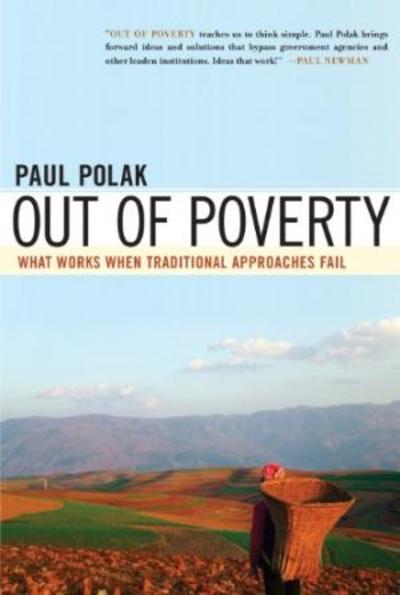Out of Poverty. What Works When Traditional Approaches Fail
Harold J. Harder, Ph.D. Professor Emeritus, Trinity Western University, Langley, BC, Canada

What can the poor do to move out of poverty? In his book Out of Poverty, Paul Polak challenges the reader to take a fresh perspective on the poor—to see them for their potential to work their way out of poverty.
Many poor people are entrepreneurial in their thinking and have assets such as land to work with. With just a little help and direction, many of them can move out of poverty and in the process increase their country’s production. Polak’s work has focused extensively on the poor who have some land (most with an acre or less to work with) and who earn about a dollar a day.
Writing from twenty-five years of experience working with the poor in many countries, during which he talked with thousands of small farmers, Polak states 17 million poor people have been able to improve their income situation. With increased income, they have improved their diet, children’s education, and health care.
In 1981, Polak helped found International Development Enterprises (IDE; http://wwwideorg.org , an organization committed to serving the poor by using a business approach to development for the benefit of the poor. But Polak argues that a shift in thinking must occur, from large business to small business—in many cases farming-based business. Rather than focusing on increasing national income in hope that some of the poor will eventually benefit, this approach focuses on improving the lot of the poor, resulting in greater national income.
In his book, Polak addresses what he calls three great poverty eradication myths.
-
We can donate people out of poverty.
-
National economic growth will end poverty.
-
Big business will end poverty.
He emphasizes the need to involve the poor in finding solutions. Talk to the poor in order to understand their situation, and come alongside them to enable them to find solutions. There are many poor people, and their collective contribution can be enormous. Furthermore, if they are working at solving their own problems, the solutions are there for them, and not dependent on someone else’s continuing generosity.
In introducing new technologies or practices, Polak advises, “Develop the whole system cheaply enough to be affordable to a poor farm family living on three hundred dollars a year, profitable enough to pay for itself in the first year, and infinitely expandable using the profits it generates.” (p. 69).
The author gives numerous examples of successful solutions to problems faced by the poor, and shows how these solutions have been expanded to a large scale—reaching millions of people. Many deal with providing irrigation for crops at low (but unsubsidized) cost. A prime example is the treadle pump, a simple, low-cost device for pumping water from tube wells. Using this technology, farmers who live where the water table is relatively high can irrigate about one-half an acre (0.2 ha) of land. When the land is then used to grow vegetables and/or fruit at a time when these are not abundant in the market, farmers’ incomes are increased. Many experience better nutrition as well as increased income, and can pay for their investment in a year. Another technology reported on is low-cost drip irrigation—a system that provides efficient water distribution for increased crop production. IDE refined the drip irrigation concept with a goal of reducing cost down to where the small-plot farmer can afford it.
With access to irrigation, farmers also need appropriate agricultural knowledge to grow high-value crops, and appropriate marketing of their product in order to lift them out of their poverty. This is where outside assistance can be especially beneficial. The significance of Polak’s approach to agricultural development comes into perspective when we realize that 85% of farms in the world are smaller than 5 acres (2 hectares), yet produce more than half of the crops, meat, and dairy products in most developing countries. Surely small-scale farmers deserve more attention in research and extension efforts, to increase production and improve the living conditions of the poor. Much more effort should be directed their way.
Out of Poverty encourages readers to see the potential of the poor to improve their own situation under the right circumstances. Rather than simply criticizing failure, the book shares with the reader working solutions and a perspective that will help in finding further solutions. Polak’s book is refreshing and readable. It is highly recommended for development planners and practitioners who care to enable the poor to better their own situation on a continuing basis.
Out of Poverty is available from www.amazon.com. We also hope to have it available from ECHO’s bookstore soon.
Publication Details
- Published: 2008
- Publisher: Berrett-Koehler
- ECHO Asia Library: DC.006